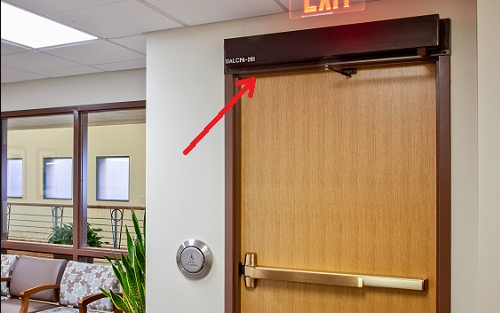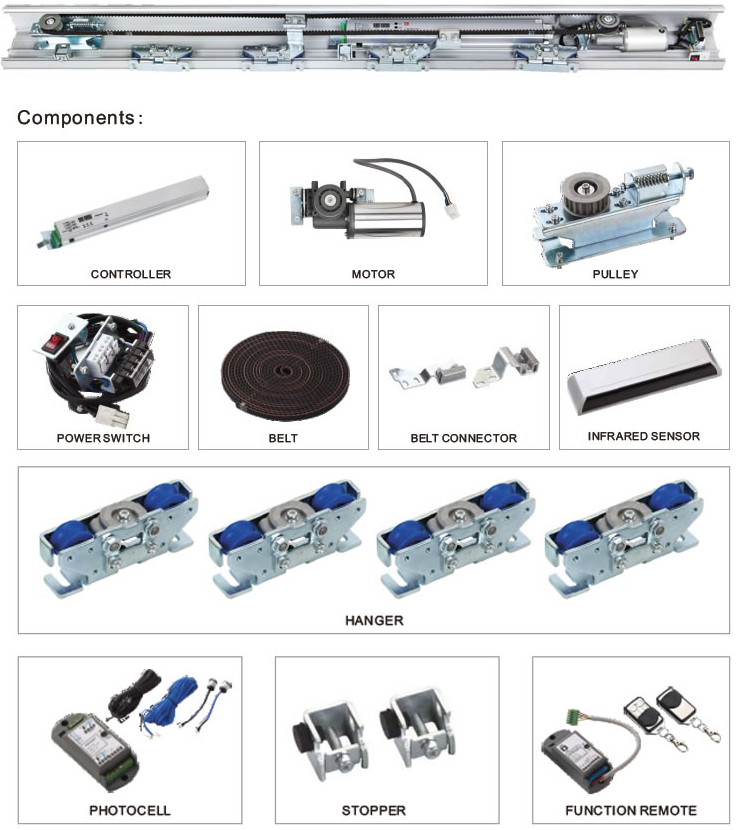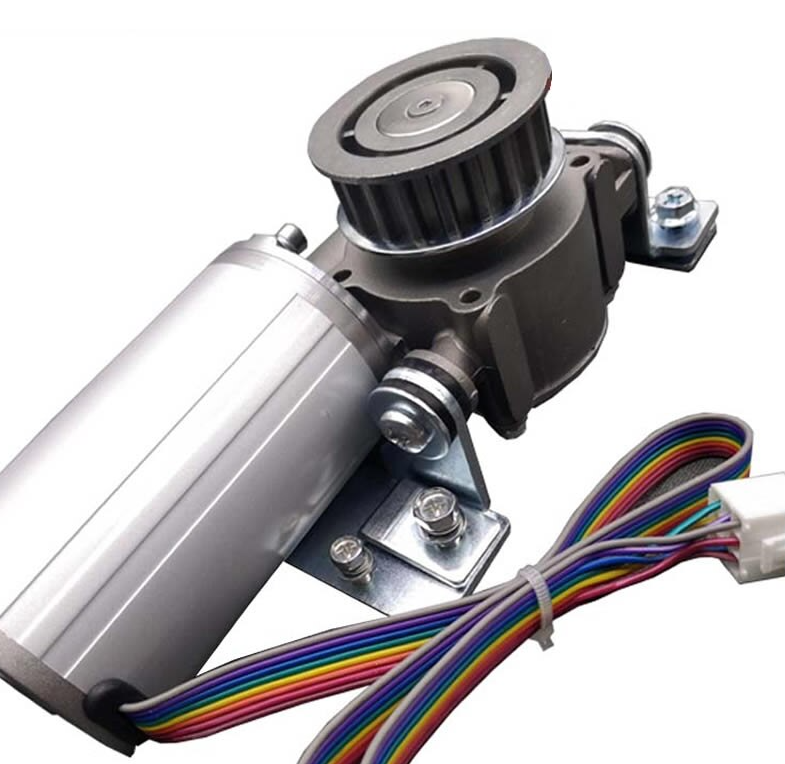Various types of motors are used in automatic doors, such as DC motors for low-power residential doors and AC motors for commercial applications.
Types of Automatic Doors
Automatic doors have become an essential part of modern architecture, offering convenience, security, and energy efficiency. Various types of automatic doors suit different architectural needs, ranging from shopping malls to airports and hospitals. Let’s delve into the different types available.

Sliding Doors
Sliding doors are one of the most commonly used types of automatic doors. They are primarily seen in commercial spaces and public buildings.
- Mechanism: Utilizes a motorized system to slide horizontally, either in a single or double-door format.
- Advantages: Space-saving, energy-efficient, and highly convenient for high-traffic areas.
- Common Uses: Shopping Malls, Hospitals, Airports.
Swinging Doors
Unlike sliding doors, swinging doors open outward or inward, making them ideal for specific architectural requirements.
- Mechanism: Operated by a hydraulic or pneumatic closure, often with a backup power source.
- Advantages: Can be more accessible for people with disabilities and can be more tightly sealed.
- Common Uses: Offices, Universities, Residential Buildings.
Folding Doors
Folding doors, also known as accordion doors, fold into themselves, allowing for a wide entrance or exit.
- Mechanism: Panels are connected with hinges and slide and fold along a track.
- Advantages: Ideal for spaces where side room is limited but a wider opening is necessary.
- Common Uses: Commercial Spaces, Balconies, Patio Doors.
Revolving Doors
Revolving doors consist of three or four doors that hang on a central shaft and rotate around a vertical axis within a cylindrical enclosure.
- Mechanism: Constantly rotates either manually or with motorized assistance.
- Advantages: Excellent for maintaining indoor temperature and reducing drafts.
- Common Uses: Hotels, Corporate Buildings, High-end Retail Stores.
Components of Automatic Doors
Understanding the components that make up an automatic door system is crucial for both installation and maintenance. The efficiency, reliability, and safety of an automatic door depend on the harmonious operation of these components. Here’s a detailed look at each of the essential parts.
Sensors
Sensors act as the ‘eyes’ of the automatic door system, detecting movement or presence near the door to trigger its opening or closing.
- Types: Infrared, Radar, Ultrasonic, and Laser sensors.
- Placement: Usually placed above the door or embedded in the floor.
- Functions: Detecting motion, weight, or even temperature changes to operate the door.
Door Material
The material used for the door not only affects the aesthetics but also the door’s durability and functionality.
- Common Materials: Glass, Aluminum, Steel, and Wood.
- Considerations: Weight, durability, and insulation properties.
- Applications: Glass for visual appeal in retail stores, steel for high-security areas like banks.
Control Systems
The control system serves as the ‘brain’ of the automatic door, coordinating between the sensors and the motor to ensure smooth operation.
- Types: Microcontroller-based, PLC (Programmable Logic Controller), or even computer-controlled systems.
- Functions: Timing, motor control, safety features, and emergency operations.
- Compatibility: Must be compatible with the types of sensors and motors used, as well as with any backup power systems.
Types of Motors Used
The type of motor used in an automatic door system has a significant impact on its performance, durability, and efficiency. There are several types of motors, each with its own set of characteristics suited for particular applications. Let’s take an in-depth look at the types of motors commonly used in automatic doors.
DC Motors
DC (Direct Current) motors are commonly used in low-power and battery-operated automatic doors.
- Mechanism: Operates on direct current and consists of a stator and rotor.
- Advantages: High torque, energy-efficient, and relatively easy to control.
- Common Uses: Residential sliding doors, garage doors, small commercial installations.

AC Motors
AC (Alternating Current) motors are more common in heavy-duty or high-traffic commercial applications.
- Mechanism: Runs on alternating current and generally more rugged than DC motors.
- Advantages: Durable, cost-effective for long-term use, and simpler design.
- Common Uses: Shopping malls, airports, large public transit stations.
Stepper Motors
Stepper motors offer high precision, often used in specialized applications that require accurate positioning.
- Mechanism: Rotates in discrete step angles, allowing for excellent control without a feedback system.
- Advantages: Highly accurate, provides good torque at low speeds.
- Common Uses: Automatic doors in clean rooms, laboratories, or other precision-based environments.
Synchronous Motors
Synchronous motors run at a constant speed, making them ideal for applications where consistent operation is crucial.
- Mechanism: Operates in sync with the supply current frequency, providing constant speed.
- Advantages: Energy-efficient, highly reliable, and suitable for high-torque applications.
- Common Uses: Revolving doors in hotels or corporate buildings.
Motor Selection Criteria
Choosing the right motor for an automatic door system is a crucial step, as it directly affects the door’s performance, safety, and energy efficiency. Below are some key criteria to consider when selecting a motor for an automatic door.
Power Requirements
Understanding the power needs of your automatic door system is the first step in selecting an appropriate motor.
- Voltage and Current: Check the voltage and current specifications to ensure compatibility with your electrical system.
- Load Capacity: Make sure the motor can handle the weight and size of the door.
- Common Uses: High-power requirements for large commercial spaces, and low-power for residential applications.

Speed and Torque
The speed and torque of a motor define how fast and how powerfully it can move the door.
- RPM (Revolutions per Minute): Higher RPM often means faster door operation but might compromise on torque.
- Torque Requirements: Heavier doors require motors with higher torque.
- Applications: Fast speeds for high-traffic areas like airports, and higher torque for heavy-duty doors in industrial settings.
Efficiency
Motor efficiency is a measure of how well a motor converts electrical energy into mechanical energy.
- Energy Consumption: Lower consumption is preferable for cost-saving and environmental reasons.
- Heat Dissipation: Efficient motors dissipate less heat, extending their lifespan.
- Common Uses: Green buildings often prioritize highly efficient motors to minimize energy costs.
Cost
While it may be tempting to opt for the cheapest motor available, this can often lead to higher maintenance and energy costs in the long run.
- Initial Cost vs. Long-term Value: Weigh the initial investment against the expected lifespan and maintenance costs.
- Warranty and Support: Check if the manufacturer offers robust after-sales support and warranty.
- Cost-benefit Analysis: Sometimes, more expensive motors are cost-effective when you factor in efficiency and durability.
